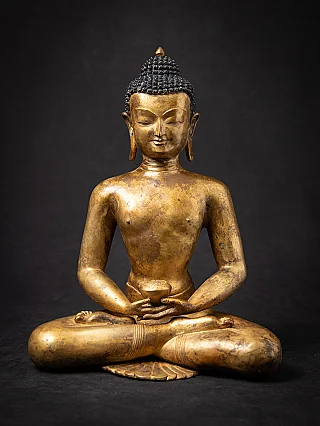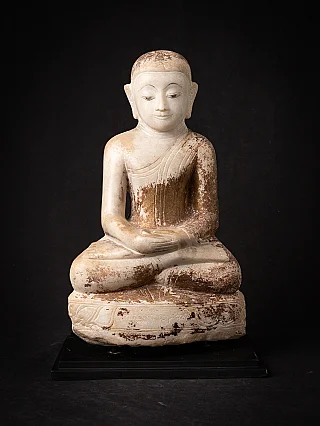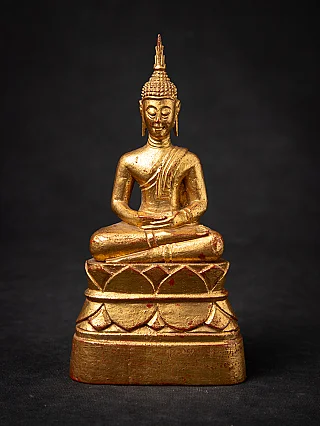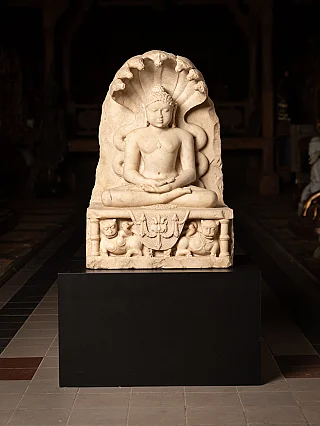Buddha Statue in Meditation
Author : Peter Vredeveld

Image by Freepik.com
Utilizing Iconography to Cultivate Inner Peace
Meditation has been a cornerstone of spiritual practices for centuries, with numerous mental and physical health benefits. It involves training the mind to focus on a specific object, thought, or activity to cultivate a sense of calm, clarity, and mindfulness. In the context of meditation, Buddha statues can serve as powerful visual aids, helping practitioners to anchor their focus and bring a sense of serenity to their practice.

The history of Buddha statues in meditation stretches back over two thousand years, with the earliest known examples dating back to the 3rd century BCE in ancient India. In the centuries since, these statues have become integral to spiritual practices worldwide, serving as physical representations of the Buddha and as powerful tools for meditation and contemplation.
Selecting a Symbolically Significant Statue
The choice of a Buddha statue for meditation is highly personal and should be based on an individual's beliefs and values. With a vast array of styles and symbols, selecting a statue that holds meaning and resonance for the practitioner is essential. Some common themes in Buddha iconography include the seated pose, which represents the Buddha's enlightenment and inner peace; the standing or walking pose, which signifies compassion and guidance; and hand gestures known as mudras, which convey specific spiritual meanings.
One crucial factor to consider when choosing a Buddha statue is the material it is made from. Traditional materials include bronze, stone, and wood, each with unique properties and symbolism. For example, bronze statues are often associated with strength and stability, while stone statues are thought to carry the earth's energy. On the other hand, wood statues are believed to bring a sense of warmth and vitality to a space. Consider the most meaningful material and choose an inspiring and resonant statue.
The size and scale of the statue are also worth considering. Smaller statues may be more practical for those limited in space, while those with a dedicated meditation room or altar may prefer an enormous statue as the centerpiece. Ultimately, the statue's size should be based on your personal preferences and needs and the size of the space in which it will be placed.
Creating a Sacred Space
Establishing a dedicated space for meditation can be incredibly beneficial, providing a consistent location for practice and fostering a sense of calm and focus. Consider incorporating the Buddha statue as a focal point when setting up this space. Choose an area free from distractions, and consider incorporating elements that promote a sense of peace, such as calming colors, scents, comfortable seating, or a meditation cushion.
Original Buddha statues for your Meditation room
Utilizing the Statue as a Visual Anchor

One of the primary benefits of using a Buddha statue in meditation is utilizing it as a visual anchor. The serene expression and posture of the statue can serve as a powerful reminder to bring the mind to the present moment and cultivate a sense of inner peace. When focusing on the statue, allow yourself to be drawn into its calming energy, enabling it to guide your meditation practice.
Some practitioners find placing the statue at eye level helpful, while others prefer to have it slightly above or below. Experiment with different placements and see what feels most comfortable and conducive to your practice. It's also worth considering the direction the statue is facing. In traditional Buddhist iconography, the Buddha faces outward, symbolizing his teachings and guidance. However, some practitioners find it more conducive to their practice to have the statue facing inward, towards the altar or shrine. Experiment with different placements and see what feels most meaningful to you.
Incorporating Mantras and Affirmations
In addition to serving as a visual anchor, Buddha statues can be used with mantras and affirmations. A mantra is a word or phrase repeated during meditation to focus the mind and bring calm and clarity. An affirmation is a positive statement repeated to affirm a particular belief or intention. When using a Buddha statue in meditation, consider incorporating mantras or affirmations to enhance the experience and bring focus and purpose to the practice.
Some common mantras used in Buddhist meditation include "Om mani padme hum," which translates to "the jewel in the lotus" and is believed to invoke the blessings of the Buddha; "Om muni muni maha muniye svaha," which is a tribute to the historical Buddha and is thought to bring about compassion and wisdom; and "Nam-myoho-renge-kyo," which is a mantra of the Lotus Sutra and is believed to bring about enlightenment and inner peace. Experiment with different mantras and see which ones resonate most with you.
Affirmations can also be a powerful meditation tool, helping cultivate positive thoughts and beliefs. Some examples of affirmations that might be used in conjunction with a Buddha statue include "I am at peace," "I am filled with love and compassion," and "I am connected to the present moment." Experiment with different affirmations and see which ones feel most meaningful to you.
Where to Find Buddha Statues for Meditation
If you want to purchase a Buddha statue for meditation, numerous online retailers offer a wide selection of high-quality statues. One reliable source is originalbuddhas.com, which has a vast collection of beautifully crafted statues. You can browse and purchase from the comfort of your home with the peace of mind of knowing that you are supporting a reputable and reliable source.
Conclusion
Buddha statues can be a powerful tool for enhancing meditation practices and cultivating inner peace. By choosing a symbolically significant statue, creating a dedicated space, utilizing the statue as a visual anchor, and incorporating mantras and affirmations, practitioners can benefit significantly from incorporating these icons into their meditation routines. Consider trying it and see its positive impact on your practice.
Share this page















































